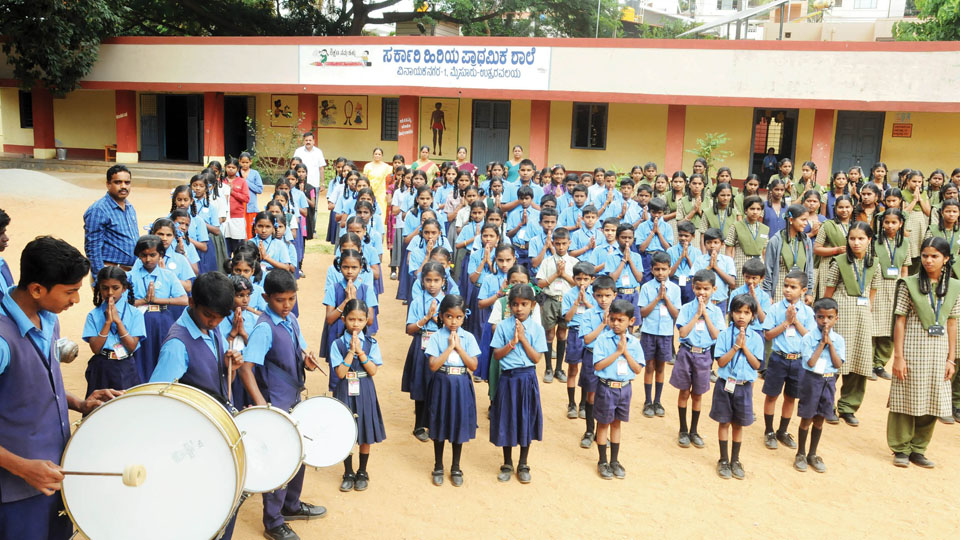Mysore/Mysuru: There is a commonly held belief that private school managements ‘hijack’ seats allocated under the Right To Education (RTE) quota. However, statistics present a contrasting scenario: Every year, thousands of seats designated for disadvantaged groups in the State are left unoccupied. Since 2018, the introduction of amendments to the Right of Children to Free and Compulsory Education Act, 2009 (RTE Act) by the Karnataka Government has resulted in a shift of priority from private schools to Government schools. Consequently, the admission of children from weaker sections and disadvantaged groups into the reserved 25 percent RTE seats has witnessed a decline.
In Mysuru, out of the 815 seats available under the RTE quota in the academic year 2023-24, not even half of the seats have been filled up. The Department of School Education and Literacy Public Education (DSEL) and the Education Department have finished first round of allocating seats and there has been a lack of response or call it absence of enthusiasm from the parents.
Gone are the days when there is a scramble for RTE seats and at times, parents used to stage protests in front of schools demanding seats for their children. Though the DSEL is conducting the second and third rounds of selections or seat allocation, they are destined to be a name-sake process owing to the general lack of interest among parents.
Seat share and occupancy in Mysuru
Looking at the statistics, Mysuru North has got 406 RTE seats, South has got 182, 55 for H.D. Kote, 43 for K.R. Nagar, Mysuru Rural has got 33 Nanjangud 30, T. Narasipur 25, 23 for Hunsur, and Periyapatna has got 18 seats under RTE taking the total to 815 seats. Of them, 446 seats were allocated in the first round and only 342 children filled up the seats.
Only 246 seats have been filled in Mysuru North in the first round, the highest. In the South, 83 students have filled up, 5 each in H.D. Kote and Hunsur, 2 in K.R. Nagar and only one student has opted for an RTE seat in Mysuru Rural. There are no takers for RTE seats in Periyapatna, T. Narasipur and Nanjangud.
Officials told Star of Mysore that since the first round began on a lacklustre note, the second and third rounds will also be dull, leaving a huge gap between the availability of the seats and the actual filled-up seats.
Why the decline?
In an effort to ensure quality education for children from weaker sections and disadvantaged groups, the Union Government introduced the RTE Act. One of its provisions involved reserving 25 percent of seats in private schools under the RTE quota. In Karnataka, the Act was implemented in 2010, and rules were established in 2012.
However, in 2018, the Karnataka Government made amendments to the Act, citing a shortage of students in Government and aided schools and the desire to reduce the significant amount of money paid to private schools as fee reimbursement for RTE quota students. The amendment modified Rule 4 of the RTE Act to include Government and aided schools within the definition of ‘neighbourhood schools,’ a concept previously exclusive to private schools. According to this, a child can only be admitted to a private school under the RTE quota if there are no Government or aided schools in the vicinity. Consequently, the number of RTE seats in Karnataka was reduced, and the interest in admission through the RTE quota has also declined. The takers for RTE seats have come down substantially also due to lack of awareness.
What happens to empty seats?
When reserved seats under the RTE quota remain unoccupied, schools are required to keep them empty until the entire RTE admission process is completed. Only after the conclusion of the RTE process can these vacant seats be offered to students from the general category.
The challenge lies in the timeline of the RTE process, which typically extends until July. By that time, the academic year would have already begun, making it difficult for schools to fill up these vacant seats. As a result, schools often face the practical difficulty of finding suitable candidates for these seats once the RTE process is concluded.
More and more parents attracted to Government schools
A concerned parent raised a valid point regarding the desire for their child to attend a good school. If schools do not meet certain quality standards, it is natural for parents to hesitate in admitting their children there.
The parent suggested that all schools should be assessed based on criteria such as infrastructure, teacher-student ratio and past examination results. Only those schools that meet the requirements should fall under the purview of the RTE Act.
Furthermore, there have been reports of private schools demanding additional funds from parents of RTE students in the guise of extra-curricular activities. This perceived exploitative behaviour may have discouraged parents from applying for seats under the RTE quota, according to officials. Additionally, there has been a noticeable improvement in the state of Government schools or public schools. Parents are now becoming aware of the facilities and activities provided by public schools. It is possible that parents are increasingly choosing Government schools over private schools due to these positive changes.
This post was published on June 18, 2023 7:39 pm


